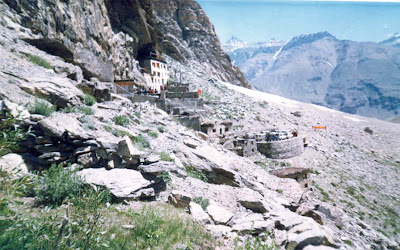


Zanskar Valley:
The western parts of Ladakh comprising the river valleys, which are drained and formed by the Himalayan tributaries of the high Indus, constitute Kargil district. Zanskar is a subdistrict or tehsil of the Kargil district, which lies in the eastern half of the Indian state of Jammu and Kashmir. The administrative centre is Padum. Zanskar, together with the neighbouring region of Ladakh, formerly belonged to Guge or Western Tibet.
Prominent among these are the spectacular valleys of Suru and Zanskar, which lie nestled along the northern flank of the Great Himalayan wall. The smaller lateral valleys of Drass, Wakha-Mulbek and Chiktan constitute important subsidiaries.
Thus, while the Mons are believed to have introduced north-Indian Buddhism to these valleys, the Dard and Balti immigrants are credited with introducing farming and the Tibetan nomads with the tradition of herding and animal husbandry.
Geography:
Zanskar is a tri-armed valley system situated between the Great Himalayan Range and the Zanskar mountains, the three arms radiating star-like towards the west, north and south from a wide central expanse. Here the Zanskar River comes into being by the confluence of its two Himalayan tributaries, the Stod/Doda and the Lingti-Tsarap rivers. It is mainly along the course of this valley system that the region's approximately 14,000 strong, mainly Buddhist population, live.
Spread over an estimated geographical area of 5000 sq kms of mountainous territory, Zanskar is surrounded by high-rise mountains and deep gorges.
It remains inaccessible for nearly 8 months a year due to heavy winter snowfall resulting in closure of all access passes, including the Penzi-la. This geographical isolation and the esoteric nature of Buddhism practised here have enabled its inhabitants to preserve their identity, so that to-day Zanskar is the least interfered with microcosms of Ladakh. Closer observation of the lifestyle evokes admiration for a people who have learnt to live in perfect harmony with the unique environment.
Flora and fauna:
Much of Zanskar's vegetation is found in the lower reaches of the valleys, and consists of alpine and tundra species. Most impressive are the meadows covered with thousands of edelweiss. At the foot of the Gumburanjon mountain blue poppies can be found. Domesticated animals such as the yak, dzo, sheep, horse, and dog are found in the region.
Zangla:
Lying deep in the northern arm of Zanskar at the end of the 35 km long road from Padum, Zangla was being ruled by a titular king till his death a few years back. The old castle now in ruins except for a small chappel, occupies a hill, overlooking the desertic valley below.
Stongdey:
The monastery of Stongdey lies 18 km to the north of Padum, on the road leading to Zangla. An old foundation associated with the Tibetan yogi, Marpa, Stongdey is now the second largest monastic establishment of Zanskar, inhabited by the resident community of about 60 Gelukpa monks. The sprawling white-washed complex has a number of temples, each a repository of the region's rich monastic legacy.
Panikhar:
Panikhar is an important place in the Zanskar Valley that is the border of the Suru Valley. At Panikhar the fort of Zorawar Singh is a major tourist attraction
Penzella Pass:
Penzella Pass that divides the Zanskar valley with the Suru Valley. Besides being the excellent camping site the Penzella Pass is a vintage point offering excellent views of the majestic mountains and the captivating countryside.




























